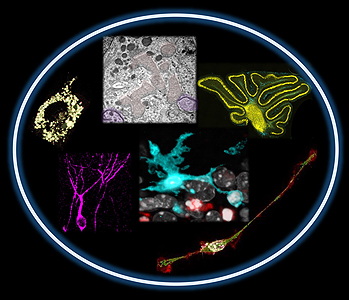-
Interferons: Invited guests at the brain’s gala banquet
Márquez-Ropero, Mar; Sierra, Amanda
Neuron
(Apr, 2024)
DOI: 10.1016/j.neuron.2024.03.010
-
Microglia and meningeal macrophages depletion delays the onset of experimental autoimmune encephalomyelitis

Montilla, Alejandro; Zabala, Alazne; Er-Lukowiak, Marco; Rissiek, Björn; Magnus, Tim; Rodriguez-Iglesias, Noelia; Sierra, Amanda; Matute, Carlos; Domercq, María
Cell Death & Disease
(Jan, 2023)
DOI: 10.1038/s41419-023-05551-3
-
Microglial phagocytosis dysfunction in stroke is driven by energy depletion and induction of autophagy

Beccari, Sol; Sierra-Torre, Virginia; [...] Plaza-Zabala, Ainhoa; Sierra, Amanda
Autophagy
(Jan, 2023)
DOI: 10.1080/15548627.2023.2165313
-
Microglia states and nomenclature: A field at its crossroads
Paolicelli, Rosa C.; Sierra, Amanda; [...] Wu, Long-Jun; Wyss-Coray, Tony
Neuron
(Nov, 2022)
DOI: 10.1016/j.neuron.2022.10.020
-
Susceptibility of Female Mice to the Dietary Omega-3/Omega-6 Fatty-Acid Ratio: Effects on Adult Hippocampal Neurogenesis and Glia

Rodríguez-Iglesias, Noelia; Nadjar, Agnes; Sierra, Amanda; Valero, Jorge
International Journal of Molecular Sciences
(Mar, 2022)
DOI: 10.3390/ijms23063399
-
Editorial: Assessing Microglial Function and Identity

Sierra, Amanda; Paolicelli, Rosa Chiara
Frontiers in Immunology
(Dec, 2021)
DOI: 10.3389/fimmu.2021.824866
-
Regulation of hippocampal postnatal and adult neurogenesis by adenosine A2A receptor: interaction with brain-derived neurotrophic factor
Ribeiro, Filipa F.; Ferreira, Filipa; Rodrigues, Rui S.; Soares, Rita; Pedro, Diogo M.; Duarte-Samartinho, Marta; Aroeira, Rita I.; Ferreiro, Elisabete; Valero, Jorge; Solá, Susana; Mira, Helena; Sebastião, Ana M.; Xapelli, Sara
STEM CELLS
(May, 2021)
DOI: 10.1002/stem.3421
-
Coupled Proliferation and Apoptosis Maintain the Rapid Turnover of Microglia in the Adult Brain
Askew, K.; Li, K.; Olmos-Alonso, A.; Garcia-Moreno, F.; Liang, Y.; Richardson, P.; Tipton, T.; Chapman, M.A.; Riecken, K.; Beccari, S.; Sierra, A.; Molnár, Z.; Cragg, M.S.; Garaschuk, O.; Perry, V.H.; Gomez-Nicola, D.
Cell Reports
(Jan, 2017)
DOI: 10.1016/j.celrep.2016.12.041


